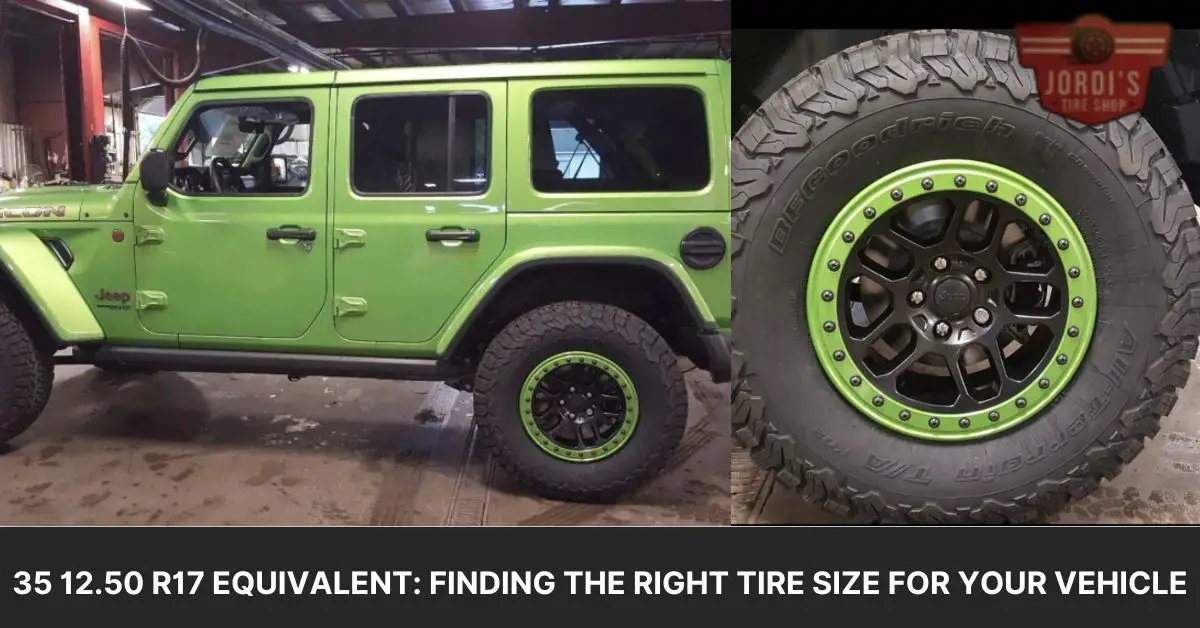We’ve all been there, standing in front of a tire rack or scrolling through pages online, trying to make sense of tire sizes. It’s like trying to decipher an ancient code. But don’t worry, we’re here to crack the code on one specific size: 35 12.50 r17. Understanding this size and its equivalents can be a game-changer for your vehicle, whether you’re hitting off-road trails or cruising the highway.
Finding the right tire size isn’t just about making sure it fits. It’s about optimizing performance, safety, and even fuel efficiency. So, let’s dive into the world of tire sizes together, starting with the popular 35 12.50 r17. We’ll explore its equivalents and why knowing them might just be your ticket to a smoother ride and a better driving experience.
Understanding the “35 12.50 r17 Equivalent” Term

Diving deeper into tire sizes, we’ll explore what the “35 12.50 r17” size really means and its equivalents. This size notation can seem like a complex code at first, but it’s quite straightforward once broken down. The “35” refers to the tire’s diameter in inches, “12.50” is the tire width in inches, and “r17” means the tire fits a 17-inch diameter wheel. Knowing this is critical for ensuring the tire not only fits your vehicle but also performs as expected.
Looking for equivalents, we’re essentially seeking tires that match or closely match the dimensions of a 35 12.50 r17 tire. This involves understanding two key aspects: dimension compatibility and performance impact. Dimension compatibility ensures the tire will fit your vehicle’s wheels and provide enough clearance in the wheel well. Performance impact refers to how a tire of a roughly equivalent size might affect your vehicle’s handling, fuel efficiency, and safety.
Equivalents to a 35 12.50 r17 tire are typically found by adjusting the width and aspect ratio numbers while trying to maintain the same diameter. For instance, tire sizes like “315/70R17” or “325/65R17” might offer a similar overall diameter but with slight variations in tire width or sidewall height. These adjustments can lead to differences in tire performance, aesthetics, and vehicle dynamics.
Before switching to an equivalent tire size, it’s vital to consult with a tire professional. They’ll help ensure the alternative size not only fits your vehicle but also aligns with your driving needs, whether you’re cruising on highways or conquering off-road trails. Understanding these equivalents, we can make informed decisions that enhance our driving experience while maintaining safety and performance.
Key Factors in Finding an Equivalent Tire

Understanding the intricacies of tire sizes, such as the 35 12.50 r17, and identifying their equivalents involves scrutinizing several key factors. These considerations ensure that the substitute tire not only fits but also preserves or enhances the vehicle’s performance and safety. Let’s dive into the essential elements to consider when searching for an equivalent tire size.
Diameter and Width
The first aspect to assess is the tire’s diameter and width. These dimensions are critical for maintaining the speedometer accuracy, ensuring proper clearance, and preserving the vehicle’s handling characteristics. A tire that closely matches the diameter of a 35 12.50 r17, for instance, minimizes the risk of speedometer discrepancies and potential rubbing issues against the vehicle’s body or suspension components.
Aspect Ratio
The aspect ratio, which determines the tire’s profile, is another crucial factor. A lower profile (shorter sidewall) can enhance handling and provide a sportier look but may reduce ride comfort and increase susceptibility to road damage. A higher aspect ratio offers a smoother ride and better absorption of road imperfections, crucial for off-road tires or those used in areas with poor road conditions.
Load Index and Speed Rating
Assessing the load index and speed rating ensures the tire can support the vehicle’s weight and perform safely at the vehicle’s highest speed. These ratings are especially important if the vehicle is frequently used for towing or transporting heavy loads. Equivalent tires must meet or exceed the original tire’s load index and speed rating to maintain safety and performance standards.
Tread Pattern and Compound
The tread pattern and compound directly influence grip, handling in wet conditions, and wear rate. For equivalent tires, choosing a tread design that suits the vehicle’s primary usage, be it highway driving, off-roading, or navigating snowy conditions, is essential. Similarly, the tire compound affects durability, traction, and performance in various temperatures.
Carefully examining these factors, we ensure that any equivalent tire we choose, like transitioning from a 35 12.50 r17 to a 315/70R17 or a 325/65R17, will offer a balance of performance, safety, and durability suitable for our driving needs and conditions.
Popular 35 12.50 r17 Equivalents
Following our discussion on the importance of selecting the right tire size for optimal performance and safety, let’s explore some popular equivalents to the 35 12.50 r17 tire. Keeping in mind the critical factors such as diameter, width, aspect ratio, load index, speed rating, tread pattern, and compound, we’ve identified a few tire sizes that match closely with the 35 12.50 r17 specifications. These equivalents can provide similar performance, ensuring that your vehicle maintains its handling, safety, and fuel efficiency.
- 315/70R17: This size is one of the closest matches, offering a similar width and diameter. It’s a common choice for drivers looking to maintain the balance between off-road capability and on-road manners.
- 325/65R17: Slightly wider than the original tire, this size may provide a bit of extra stability and grip, particularly useful for vehicles that spend a lot of time off the pavement.
- 295/75R17: While offering a narrower tread, this size maintains a diameter close to the 35 12.50 r17, making it suitable for those looking for a slightly slimmer profile without a significant impact on performance.
- 305/70R17: This size strikes a balance between width and height, providing a good option for drivers wanting to ensure their vehicle’s performance remains consistent across different terrains.
In choosing any of these equivalents, it’s essential to consider the specific characteristics of your vehicle and your driving conditions. Whether it’s for on-road comfort or off-road performance, each of these sizes offers a way to maintain the integrity of your vehicle’s capabilities while possibly introducing new benefits. Remember, consulting with a tire professional can help in making the best selection for your particular needs, ensuring that safety and performance remain paramount.
How to Choose the Right 35 12.50 r17 Equivalent for Your Vehicle

Choosing the right 35 12.50 r17 tire equivalent requires taking several factors into account to ensure the alternative size fits your vehicle perfectly and performs well under your typical driving conditions. After exploring various equivalents like 315/70R17, 325/65R17, 295/75R17, and 305/70R17, it’s clear that while there are numerous options, not all may suit your vehicle’s needs. Here’s how we can narrow down the choices:
- Check the Vehicle’s Manual: First, consult your vehicle’s manual for recommended tire sizes. Manufacturers often list acceptable tire dimensions that are guaranteed to fit your model, providing a good starting point for identifying equivalents.
- Consider Wheel Size Compatibility: Ensure the equivalents you’re looking at are compatible with your vehicle’s wheel diameter. Tires like 315/70R17 and 305/70R17 fit 17-inch rims, aligning with the original 35 12.50 r17 size.
- Evaluate Tire Load Index and Speed Rating: Opt for tires that maintain or exceed the load index and speed rating of your current tires. These ratings are crucial for safety and performance, indicating the maximum load a tire can carry and its maximum speed capability.
- Assess Driving Conditions and Preference: Think about your driving habits and the typical conditions you face. If you frequently drive off-road, you may prioritize tread pattern and durability over fuel efficiency, preferring a tire like 315/70R17 for its aggressive tread.
- Consult with Tire Professionals: Finally, seek advice from tire professionals. They can provide valuable insights on which equivalents will best suit your vehicle while maintaining safety and performance. They’ll help ensure the alternative size does not impact the vehicle’s speedometer accuracy or handling characteristics.
Considering these factors, we can make a well-informed decision on the right 35 12.50 r17 tire equivalent for our vehicle, ensuring safety, compatibility, and performance are all in alignment.
Installation and Maintenance Tips for Equivalent Tires

After guiding you through selecting a proper 35 12.50 r17 equivalent tire, it’s crucial to consider the installation and upkeep of your new tires. Keeping them in top condition ensures safety, longevity, and optimal performance. Here are our best practices for installation and ongoing maintenance of your equivalent tires.
Proper Installation
- Consult a Professional: Always have tires installed by experienced professionals. They possess the tools and know-how to mount the tires correctly, ensuring they’re balanced and aligned.
- Check Tire Pressure: After installation, verify the tire pressure matches your vehicle’s specifications. Incorrect pressure can lead to uneven wear and reduced fuel efficiency.
- Inspect for Damage: Before they’re installed, inspect the new tires for any defects or damage. Catching issues early can prevent future problems.
Maintenance Tips
- Rotate Tires: Rotate your tires according to the manufacturer’s recommendations, usually every 5,000 to 8,000 miles. This practice promotes even wear and extends the life of the tires.
- Monitor Tire Pressure: Check tire pressure monthly, including the spare, as temperature fluctuations can affect pressure levels. Keeping tires properly inflated maximizes performance and safety.
- Visual Inspections: Regularly inspect your tires for signs of wear or damage, such as cracks, bulges, or embedded objects. Early detection of these issues can prevent blowouts and other dangerous situations.
- Alignment Check: Have your vehicle’s alignment checked annually, or if you notice uneven tire wear or your vehicle pulling to one side. Correct alignment prevents unnecessary strain on your tires, improving durability and handling.
Following these installation and maintenance tips for your 35 12.50 r17 equivalent tires not only safeguards your investment but also enhances your driving experience, ensuring your journeys are as safe and efficient as possible.
Conclusion
We’ve journeyed through the ins and outs of finding the perfect 35 12.50 r17 tire equivalents, stressing not just the importance of the right fit but also how to maintain them for the road ahead. Following the steps we’ve laid out, from choosing with care to ensuring they’re looked after, means you’re not just buying tires—you’re investing in your vehicle’s future. Remember, it’s not just about getting from A to B; it’s about enjoying the journey safely and efficiently. So here’s to smooth drives and even smoother decisions, knowing you’ve got the knowledge to keep your ride in top shape.
Related Posts:
- 32×11.50r15 in Metric: Converting Tire Size for Easy Comparison
- 35×11.50r20 in Metric: Understanding Tire Size Conversion
- 33 12.5 R18 in Metric: Understanding Tire Size Conversion
- 33 12.50 R22 in Metric: Understanding Tire Size Conversion
- 33 12.50 R20 to Metric: A Quick Guide to Converting Tire Sizes
- 35 12.5 R20 Metric: Understanding Tire Size and Compatibility
- 33 12.50 R17 Metric: A Guide to Tire Size and Conversion Charts
- 35 12.50 R17 Equivalent: Finding the Right Tire Size for Your Vehicle
- 35/12.5 r18 Equivalent: Finding the Right Tire Size for Your Vehicle
- 33 12.50 r16 Equivalent: Finding the Right Tire Size for Your Vehicle







